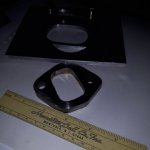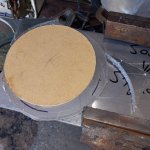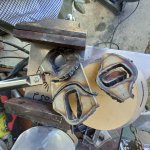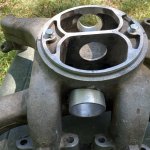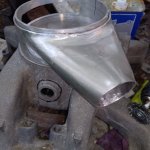My welding skills with one and one-half hands plus OCD to achieve full penetration welds makes for ugly stuff. So these will not have beautiful welds. Also, dimensions are being held with zero root gap process, a tricky option on 0.109" wall. All low carbon 304 so it doesn't really matter. Strength over looks. That is why all welds are buffed smooth on the OD.
This is a complex system..intake plus exhaust and oil supply with return. I try to spread the work around, already acquired oil supply bits, some banjo fittings bored to 1/4" for brazed hard line as it reduces failure points. Turbos require 1.25 liters per minute at 30 PSI, no issue there. Now I have to make 1/2" ID lines to drain oil plus blow by leaking from turbine and compressor shaft seals. And route it to the crankcase, both sides. Again, I am the wrench spinner so design must include my service time. 2 hours additional design and Fab time to save a minute of service time is golden with sprinkles.
My exhaust manifolds show this, glow plug swap and injector service will be easy, no disassembly required. Even the air intake will be as easy as stock, pull the air cleaner, two spring clamps and 4 bolts removes the top hat.
Still on the fence if the oil supply lines need unions. I'm an open shop guy and an oil supply line being critical should have minimal fittings. Besdes, removing would be required for valve cover access and that is constrained by injector lines.
The trick for 0.109" wall thickness pipe with no root gap is by high amperage root gap, lay wire fill and cap. .109" stainless is normally done with 75 to 90 amps since stainless is a poor conductor. Using 110 amps pulsing without filler works, knowing when you get full penetration is art. Watching the weld pool will indicate when the weld is full penetration.
The gas tungsten arc has a powerful magnetic field created by the current, no need for Maxwells Equations for the why and what. The temperatures involved plus the stainless 304 means no arc deflection but remember, induction creates eddy currents in a magnetic field. Non molten metal reduces the eddy current effects in the weld pool. Once the swirling weld puddle is seen, back off the current and move forward. Definitely move forward once the puddle dips, the swirling puddle gives a prediction of incident puddle fall through.
Korean guy above has great video. He does filler rod addition to freeze the puddle and prevent drop out. I use no filler on root, then filler for cap and fill in the lay wire method like in the video.
Stainless steel at fluid temperature burns easily, the chromium and nickel are pyrophoric, forming a black slag called sugaring. I have used Solar Flux B on joints where I can clean from the inside. All other root welds are done using argon purge. Cap and fill are done with pipe full of water, this increases fill rate and makes heat not an issue. No burn through possible.



